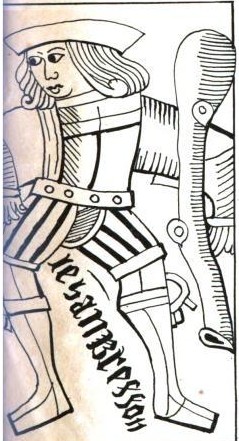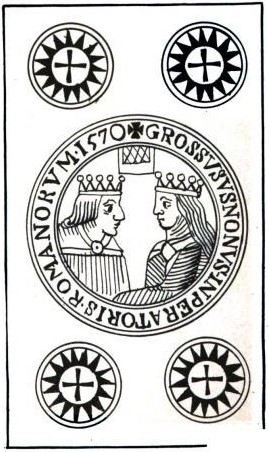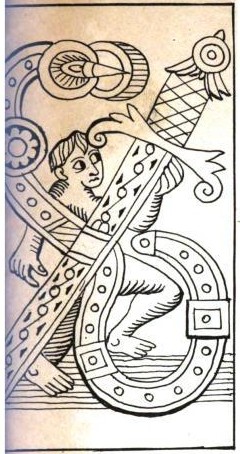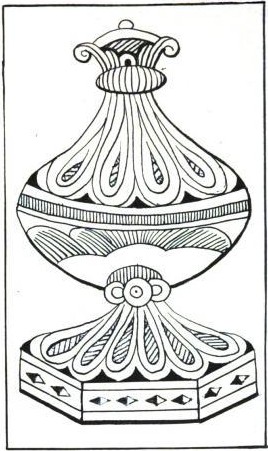The text has as major topic the Nederlaandse Doodendanse (Netherlandish Dance of the Dead) and a connection to the Flooskaartjes. The 4 reproduced cards have only documentary function, that there is no connection between Flooskartjes to the Tarot cards. In the text the cards are mentioned at p. 29 and they are given at the end of the small book (36 pages).
| p. 29 ... Reeds daarom zou ik mijnen bijval niet kunnen schenken, aan LB FRANCQ VAN BERKHEY, die veronderstelt, dat de Krieuewelkaart hier te lande in navolging van het Spaansche Tarokspil zij ingevoerd. Doch zijne meening blijkt ons bovendien ten eenenmale van grond te zijn ontbloot, zoodra wij slechts het zoo even genoemde spel inzien. 't Verwondert mij zelfs, hoe zoo iets geschreven heeft kunnen worden door VAN BERKHEY, die toch de beide Tarokspelen wel zal gekend hebben, door zijnen voorzaat WILLEM AELBRECHTZ BERKHEY, den 3den October 1574, toen Leiden was ontzet, te Leijerdorp in de schans van den spaanschen overste FRANCISCO DE VALDES gevonden. Een dier spelen [Footnote 1] in 1570 bij JEHAN BRESSON gedrukt, en thans in eigendom toebehoorende aan den Heer CHRISTIAAN VAN DER POST, te Leiden, is mij met welwillendheid ter inzage en nabootsing verstrekt. Maar ik vind daarin geene de minste overeenstemming met de Krieuwelkaart. Het viertal kaarten, dat ik daarvan heb afgeteekend,en waarvan de afdruk hierbij gaat, zal ten minsten die overeenkomst wel niet doen vinden, maar veel meer 't verbaad doen opmerken , dat er tusschen het Spaansche en Fransche kaarstspel bestaat. ... [Footnote 1: Bij ROEMER, het vijtde halve Eeuwfeest over het ontzet der Stad Leyden, bl 238, vermeld onder No. 129]. |
With thanks to the author Kwaw the 4 cards were quickly identified as the cards of an Aluette deck, so they are not Tarocchi cards. Nonetheless the 4 cards are interesting, as - according to Kwaw - Sylvia Mann gave as the oldest evident appearance of these cards the year 1587. The 4 cards, presented as reproductions, are from 1570. Some Information:
- Wikipedia to Aluette-decks
"Aluette (or la Vache, "The Cow Game") is played in Vendée and the coasts of Brittany, using a 48 card Spanish suited pack with special designs. Aluette is a very peculiar trick-taking game where suits are irrelevant. Partners use mimics to signal their hands. The mechanism is similar to that of early games like Truc / Trut and Put. The use of Spanish suited cards is surprising, but there is a theory that these suits were originally used throughout France and were displaced in most of the country by French suits when those were invented. Aluette may be an extremely old game: some late 15th-century records from the South-West of France mention a card game called Luettes. However, Nantes clearly appears as the modern cradle of the game: until c. 1700 there was in Nantes a large group of Spanish merchants, and Spanish suited cards made in Thiers (Auvergne) were conveyed on the Loire river up to Nantes where they were shipped to Bilbao and Navarra. The hypothesis of a late introduction (17th century?) through Spanish merchants in Nantes is not unlikely." - note: The producer of the deck in 1570 has a French name: Jehan Bresson - Pagat.com - Rules
- Andy Pollett - about the deck
The person of Francisco da Valdez is connected to a romantic story during the siege.
English Wikipedia: "In 1572, the city sided with the Dutch revolt against Spanish rule and played an important role in the Eighty Years' War. Besieged from May until October 1574 by the Spanish, Leiden was relieved by the cutting of the dikes, thus enabling ships to carry provisions to the inhabitants of the flooded town. As a reward for the heroic defence of the previous year, the University of Leiden was founded by William I of Orange in 1575. Yearly on October 3, the end of the siege is still celebrated in Leiden. Tradition tells that the citizens were offered the choice between a university and a certain exemption from taxes."
- Reporting Dutch text, a note to the playing couldn't be detected
- Badge worn at the relief of Leyden, 1574 by Admiral Louis de Boisot's sailors; the object has similarity to the Tarocchi object "Moon"
- Valdez picture with Magdalena Moons in his camp, where likely the Tarocchi cards were found
- Dutch wikipedia-article to Magdalena Moons, the "romantic story" of Francisco da Valdes
- Map of Leyden picture
- Picture: Bread and herings for the people of Leyden
(collected by Ross Caldwell and Huck Meyer)

Jack of Batons
shows the name of the printer
Jehan Bresson

(?) 5 of Coins

Ace of Swords

Ace of Cups